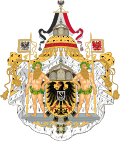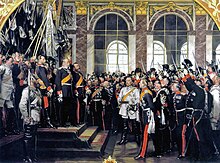German Emperor
| Emperor of the German Empire | |
|---|---|
Imperial | |
 | |
 Wilhelm II | |
| Details | |
| Style | His Imperial Majesty |
| First monarch | Wilhelm I |
| Last monarch | Wilhelm II |
| Formation | 18 January 1871 |
| Abolition | 28 November 1918 |
| Residence | Stadtschloss, Berlin |
| Appointer | Hereditary |
| Pretender(s) | Georg Friedrich |
The German Emperor (German: Deutscher Kaiser) was the official title of the head of state and hereditary ruler of the German Empire. A specifically chosen term, it was used between the 18 January 1871 proclamation of King of Prussia and President of the North German Confederation Wilhelm I as "Deutscher Kaiser" and the official abdication of Wilhelm II on 28 November 1918.[1] The Holy Roman Emperor is sometimes also called "German Emperor" when the historical context is clear, as derived from the Holy Roman Empire's official post-1512 title of "Holy Roman Empire of the German Nation."
Following the revolution of 1918, the German head of state function was succeeded by the Reichspräsident (President of the Reich), beginning with Friedrich Ebert.
German Empire (1848/1849)
In wake of the German revolutions of 1848–49 and during the German Empire (1848/1849), Frederick William IV of Prussia was offered the title Emperor of the Germans by the Frankfurt Parliament in 1849, but declined it as "not the Parliament's to give". Frederick William believed that only the German princes had the right to make such an offer, in accordance with the traditions of the Holy Roman Empire.
Creation

The title "German Emperor" was carefully chosen by Minister President of Prussia and Chancellor of the North German Confederation Otto von Bismarck after discussion which continued until the proclamation of Wilhelm I at the Palace of Versailles during the Franco-Prussian War. William I accepted this title grudgingly as he would have preferred "Emperor of Germany" (Kaiser von Deutschland); this had been unacceptable to the federated monarchs, and also would have signaled a claim to lands outside his reign (Austria, Switzerland, Luxembourg etc.).[citation needed] "Emperor of the Germans" (Kaiser der Deutschen), as had been proposed at the Frankfurt Parliament in 1849, was ruled out by William as he considered himself a king who ruled by divine right and chosen "By the Grace of God", not by the people in a popular monarchy.[citation needed]
By this ceremony, the North German Confederation (Norddeutscher Bund) was transformed into the German Empire (Deutsches Kaiserreich). This empire was a federal monarchy; the emperor was head of state and president of the federated monarchs (the kings of Bavaria, Württemberg, Saxony, the grand dukes of Baden, Mecklenburg-Schwerin, Hesse, among others, as well as the principalities, duchies and of the free cities of Hamburg, Lübeck and Bremen).[citation needed]
Under the imperial constitution, the empire was a confederation of states under the permanent presidency of Prussia. The King of Prussia was named in the constitution as the "President of the Confederation." Thus, the imperial crown was directly tied to the Prussian crown—something Wilhelm II discovered in the aftermath of World War I. He erroneously believed that he ruled the empire in personal union with Prussia. With the war's end, he conceded that he could not remain emperor, but initially thought he could at least retain his Prussian crown.[citation needed]
Full titles
The German Emperors had an extensive list of titles and claims that reflected the geographic expanse and diversity of the lands ruled by the House of Hohenzollern.
William I
His Imperial and Royal Majesty William I, By the Grace of God, German Emperor and King of Prussia; Margrave of Brandenburg, Burgrave of Nuremberg, Count of Hohenzollern; sovereign and supreme Duke of Silesia and of the County of Glatz; Grand Duke of the Lower Rhine and of Posen; Duke of Saxony, of Westphalia, of Angria, of Pomerania, Lunenburg, Holstein and Schleswig, of Magdeburg, of Bremen, of Guelders, Cleves, Jülich and Berg, Duke of the Wends and the Kassubes, of Crossen, Lauenburg and Mecklenburg; Landgrave of Hesse and Thuringia; Margrave of Upper and Lower Lusatia; Prince of Orange; Prince of Rügen, of East Friesland, of Paderborn and Pyrmont, of Halberstadt, Münster, Minden, Osnabrück, Hildesheim, of Verden, Cammin, Fulda, Nassau and Moers; Princely Count of Henneberg; Count of Mark, of Ravensberg, of Hohenstein, Tecklenburg and Lingen, of Mansfeld, Sigmaringen and Veringen; Lord of Frankfurt.[2][3]
Frederick III
His Imperial and Royal Majesty Frederick III, By the Grace of God, German Emperor and King of Prussia, Margrave of Brandenburg, Burgrave of Nuremberg, Count of Hohenzollern, Duke of Silesia and of the County of Glatz, Grand Duke of the Lower Rhine and of Posen, Duke of Saxony, of Angria, of Westphalia, of Pomerania and of Lunenburg, Duke of Schleswig, of Holstein and of Crossen, Duke of Magdeburg, of Bremen, of Guelderland and of Jülich, Cleves and Berg, Duke of the Wends and the Kashubians, of Lauenburg and of Mecklenburg, Landgrave of Hesse and in Thuringia, Margrave of Upper and Lower Lusatia, Prince of Orange, of Rugen, of East Friesland, of Paderborn and of Pyrmont, Prince of Halberstadt, of Münster, of Minden, of Osnabrück, of Hildesheim, of Verden, of Kammin, of Fulda, of Nassau and of Moers, Princely Count of Henneberg, Count of the Mark, of Ravensberg, of Hohenstein, of Tecklenburg and of Lingen, Count of Mansfeld, of Sigmaringen and of Veringen, Lord of Frankfurt.[4]
William II
His Imperial and Royal Majesty William II, By the Grace of God, German Emperor and King of Prussia, Margrave of Brandenburg, Burgrave of Nuremberg, Count of Hohenzollern, Duke of Silesia and of the County of Glatz, Grand Duke of the Lower Rhine and of Posen, Duke of Saxony, of Angria, of Westphalia, of Pomerania and of Lunenburg, Duke of Schleswig, of Holstein and of Crossen, Duke of Magdeburg, of Bremen, of Guelderland and of Jülich, Cleves and Berg, Duke of the Wends and the Kashubians, of Lauenburg and of Mecklenburg, Landgrave of Hesse and in Thuringia, Margrave of Upper and Lower Lusatia, Prince of Orange, of Rugen, of East Friesland, of Paderborn and of Pyrmont, Prince of Halberstadt, of Münster, of Minden, of Osnabrück, of Hildesheim, of Verden, of Kammin, of Fulda, of Nassau and of Moers, Princely Count of Henneberg, Count of the Mark, of Ravensberg, of Hohenstein, of Tecklenburg and of Lingen, Count of Mansfeld, of Sigmaringen and of Veringen, Lord of Frankfurt.[5]
German Emperors (1871–1918)
| Name | Lifespan | Reign start | Reign end | Notes | Family | Image |
|---|---|---|---|---|---|---|
Wilhelm I
| 22 March 1797 – 9 March 1888 (aged 90) | 18 January 1871 | 9 March 1888 | Held the Chairmanship of the Confederation (Präsidium des Bundes) as primus inter pares in the North German Confederation since 1867. | Hohenzollern |  |
| Friedrich III [7] | 18 October 1831 – 15 June 1888 (aged 56) | 9 March 1888 | 15 June 1888 | Son of Wilhelm I | Hohenzollern |  |
| Wilhelm II | 27 January 1859 – 4 June 1941 (aged 82) | 15 June 1888 | 28 November 1918 (abdicated) | Grandson of Wilhelm I Son of Friedrich III | Hohenzollern |  |
See also
- Crown of Wilhelm II
- German State Crown
- History of Germany
- Holy Roman Emperor
- List of German monarchs
- List of monarchs of Prussia
- Family tree of the German monarchs
- Year of the Three Emperors
References
- ^ Statement of Abdication of William II
- ^ https://web.archive.org/web/20071222124050/http://regiments.org/biography/royals/1859wilG.htm
- ^ Rudolf Graf v. Stillfried: Die Titel und Wappen des preußischen Königshauses. Berlin 1875.
- ^ "Titles of Frederick III". Archived from the original on 14 March 2007. Retrieved 15 October 2007.
{{cite web}}: Unknown parameter|deadurl=ignored (|url-status=suggested) (help) - ^ "Titles of William II". Archived from the original on 14 March 2007. Retrieved 15 October 2007.
{{cite web}}: Unknown parameter|deadurl=ignored (|url-status=suggested) (help) - ^ Hull 2004, p. 31.
- ^ Enumerated as successor of Frederick II who was King of Prussia 1740–1786 but not German Emperor.
Bibliography
- Hull, Isabel V. (2004), The Entourage of Kaiser Wilhelm II, 1888–1918.
- Horne, Charles F. (2009), Source Records of the Great War, Kessinger Publishing, ISBN 1104855534
